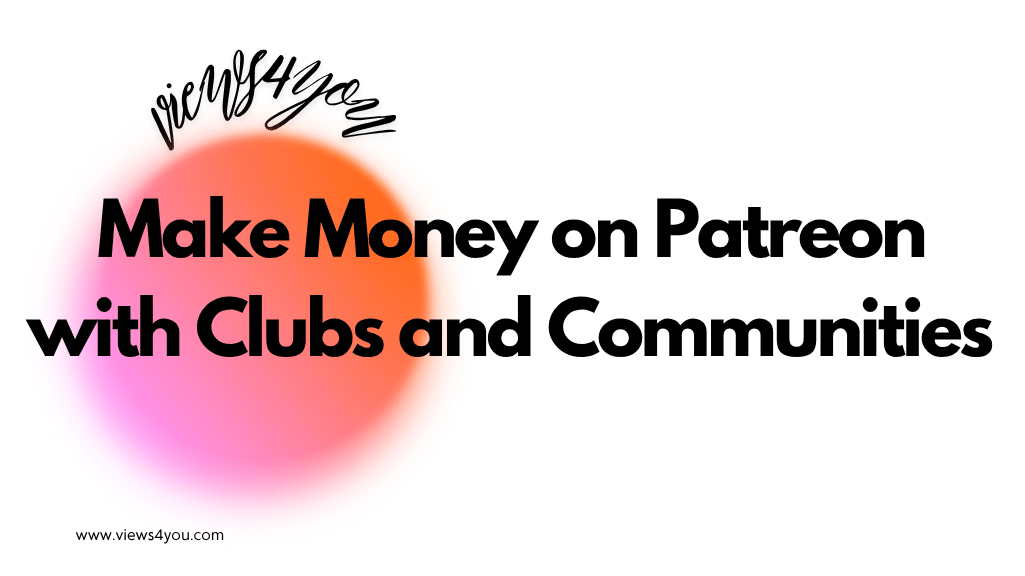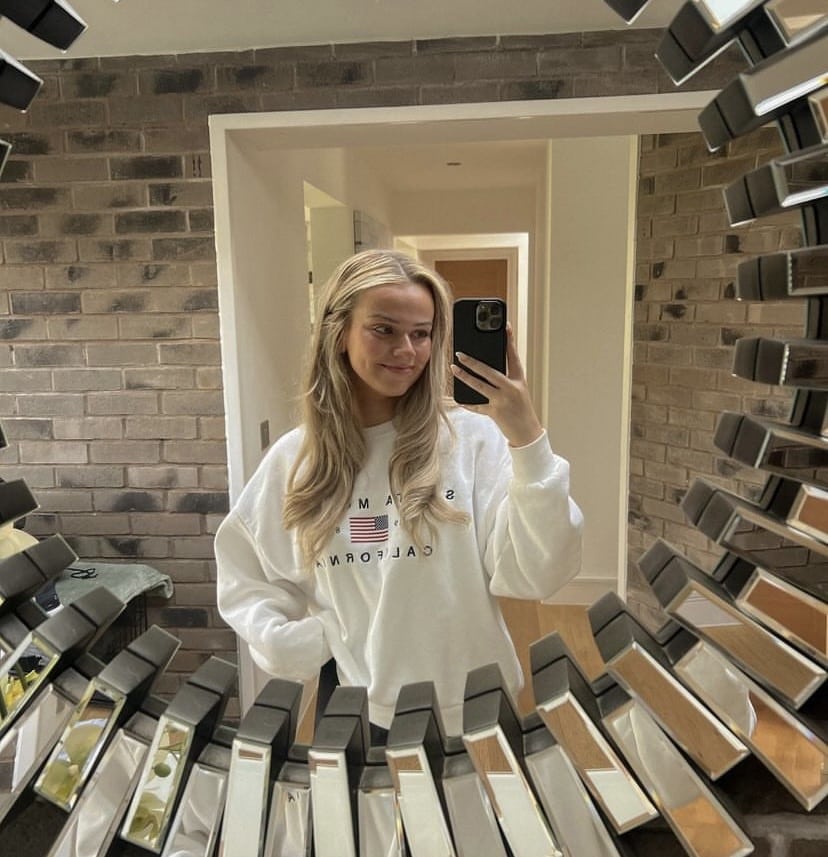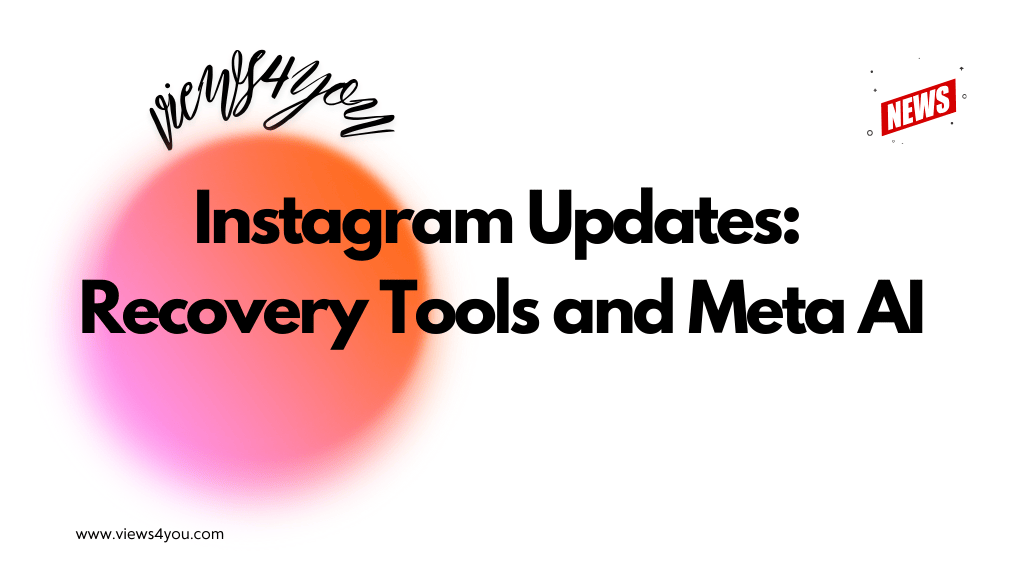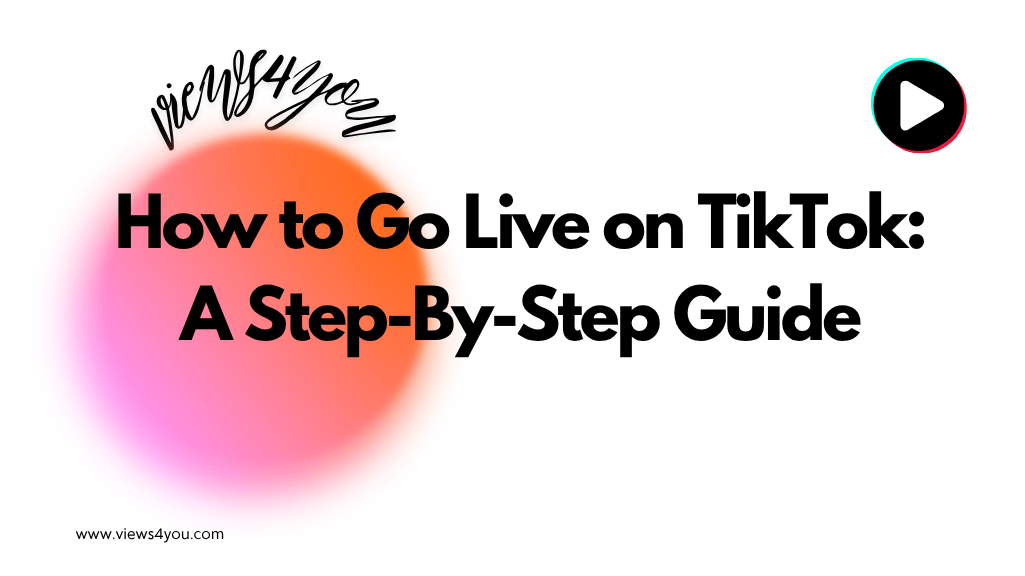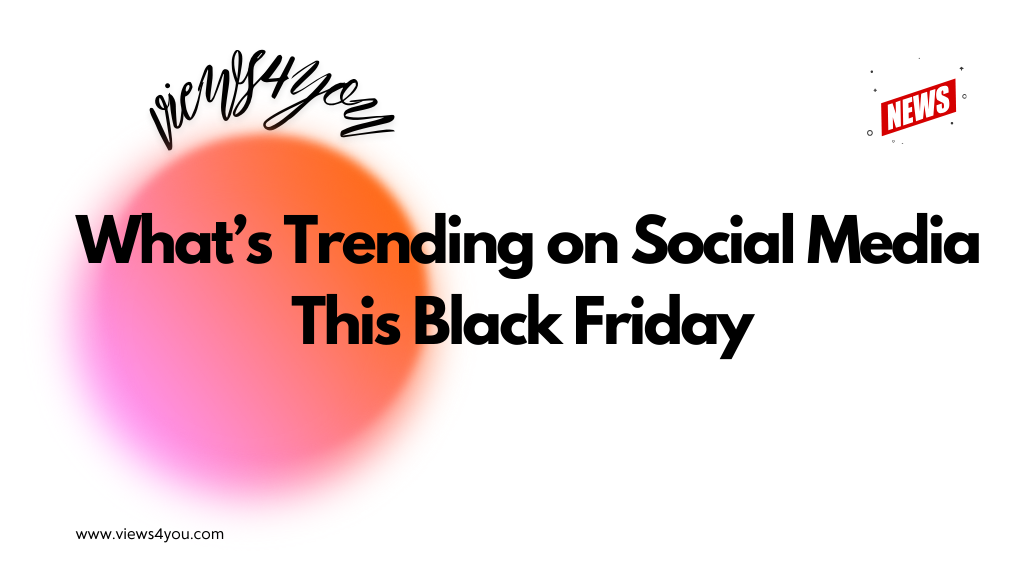Governments worldwide intensified online censorship in 2024 and early 2025 through internet shutdowns, platform bans, legal takedown demands, and arrests for social media activity. It was a record year for internet shutdowns: 296 shutdowns across 54 countries in 2024, a sharp increase from 283 shutdowns in 39 countries the year before.
Conflict and political unrest were the top triggers – Myanmar (85 shutdowns) and India (84) led the list, accounting for a huge share of global incidents. These deliberate blackouts – ranging from nationwide internet blackouts to regional social media blocks – disrupted communications and vital services, often around elections, protests, or even school exams. For example, Iraq repeatedly shut down the internet during exam periods, and Kenya blocked Telegram for three weeks during national exams.
Social Media Platform Bans & Blocks
Many governments blocked or banned major social platforms in this period, either temporarily or permanently. TikTok faced bans over national security concerns in countries like India (since 2020) and on government devices in the US, UK, Canada, and others. In Brazil, a court banned X (Twitter) in 2024 for non-compliance with local law (failing to appoint a local representative) amidst a crackdown on election disinformation. Turkey temporarily blocked Instagram during political unrest in August 2024, citing “misinformation”.
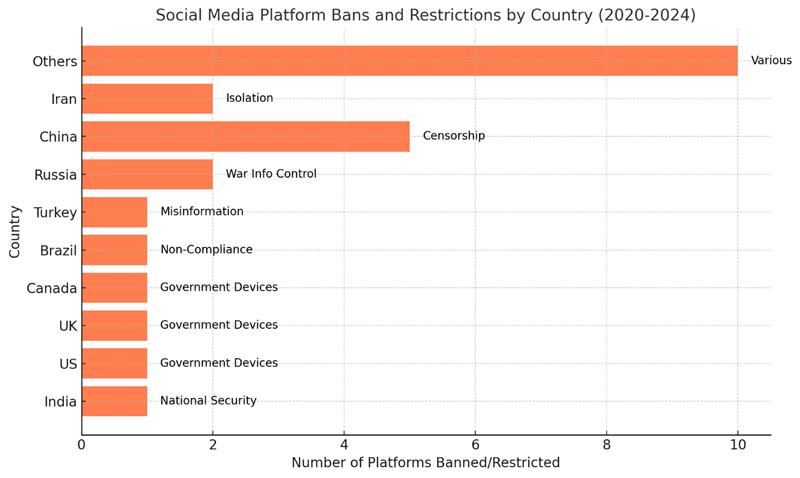
Russia continued to block Facebook and X as part of its Ukraine war information controls, while China’s Great Firewall has long kept Western social media out, forcing users onto state-controlled apps. By 2024, at least 25 countries restricted access to entire social media or messaging platforms to quell dissent. This “splinternet” trend – where the internet is fragmented by national censorship – expanded, with regimes like China and Iran wholly isolating their social media space and others (Russia, Turkey, etc.) frequently throttling or blocking platforms during sensitive times.
Government Takedown Requests
Even when not outright blocking, authorities increased legal demands for content removal. Transparency reports show governments filing tens of thousands of takedown requests to platforms. X (formerly Twitter), for instance, received 46,648 removal requests from Japan and 9,364 from Turkey in the first half of 2024 – and the company complied with 68–80% of these requests.
Under Elon Musk’s ownership, X’s global compliance with government removal demands jumped to 71% in early 2024 (up from ~51% in 2021), even as the platform professed a “free speech” stance. Other tech giants report similar pressure: Google saw an explosion of government orders this decade, with nearly 330,000 removal requests since 2020, heavily dominated by Russia (64% of requests), followed by South Korea and India. These requests target content ranging from alleged disinformation and hate speech to political criticism.
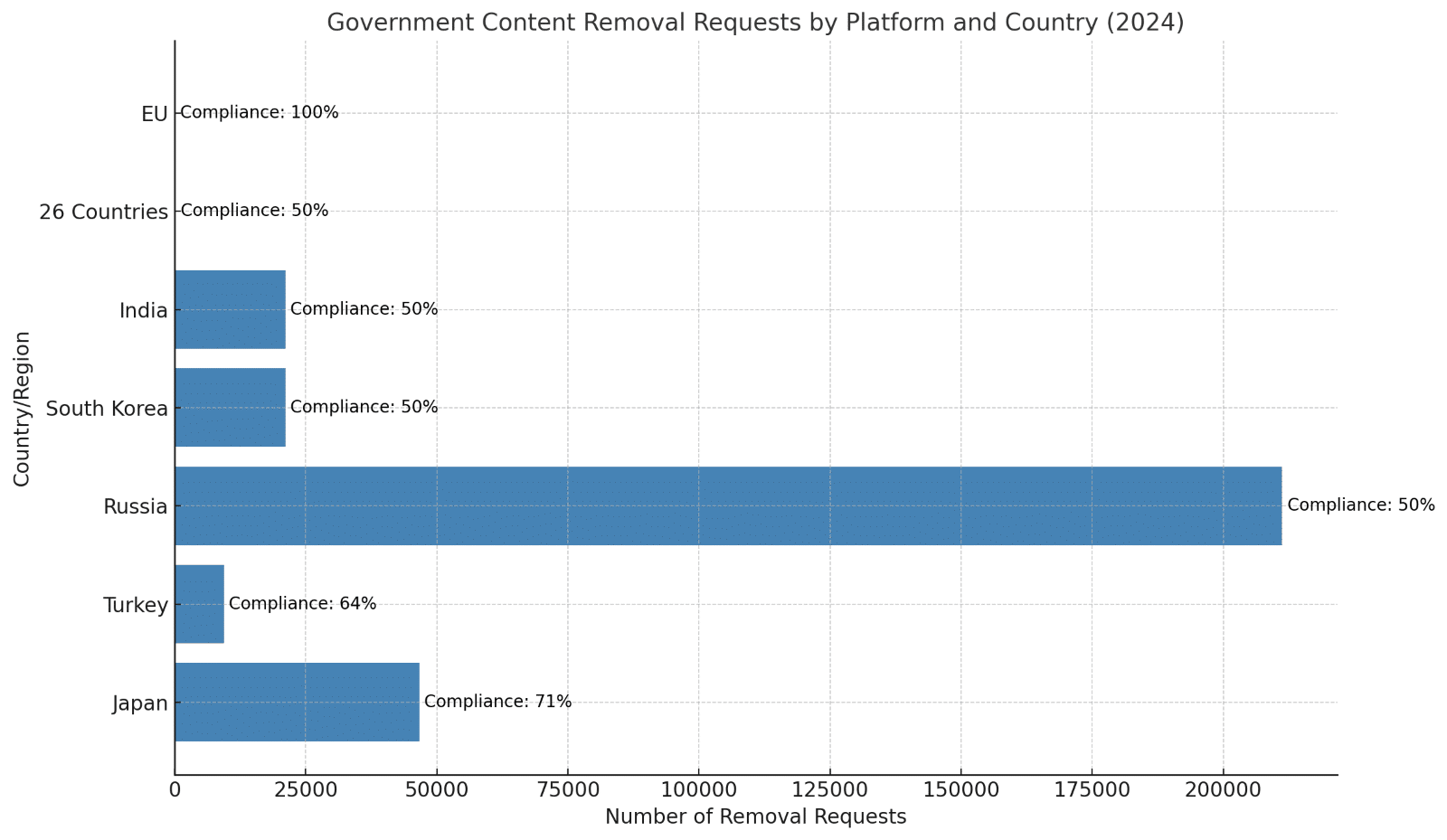
Reddit, for example, got 160 government requests from 26 countries to remove content in just the first half of 2024. Many democracies also leaned on platforms: the EU in 2024 began enforcing its Digital Services Act, empowering regulators to demand swift removal of illegal content (with fines up to 6% of global revenue for non-compliance).
Arrests and Legal Penalties for Online Speech
Repressive governments continued to arrest and jail citizens for social media posts. Freedom House reported that in at least 56 of 72 countries studied, people were arrested or imprisoned for online expression.
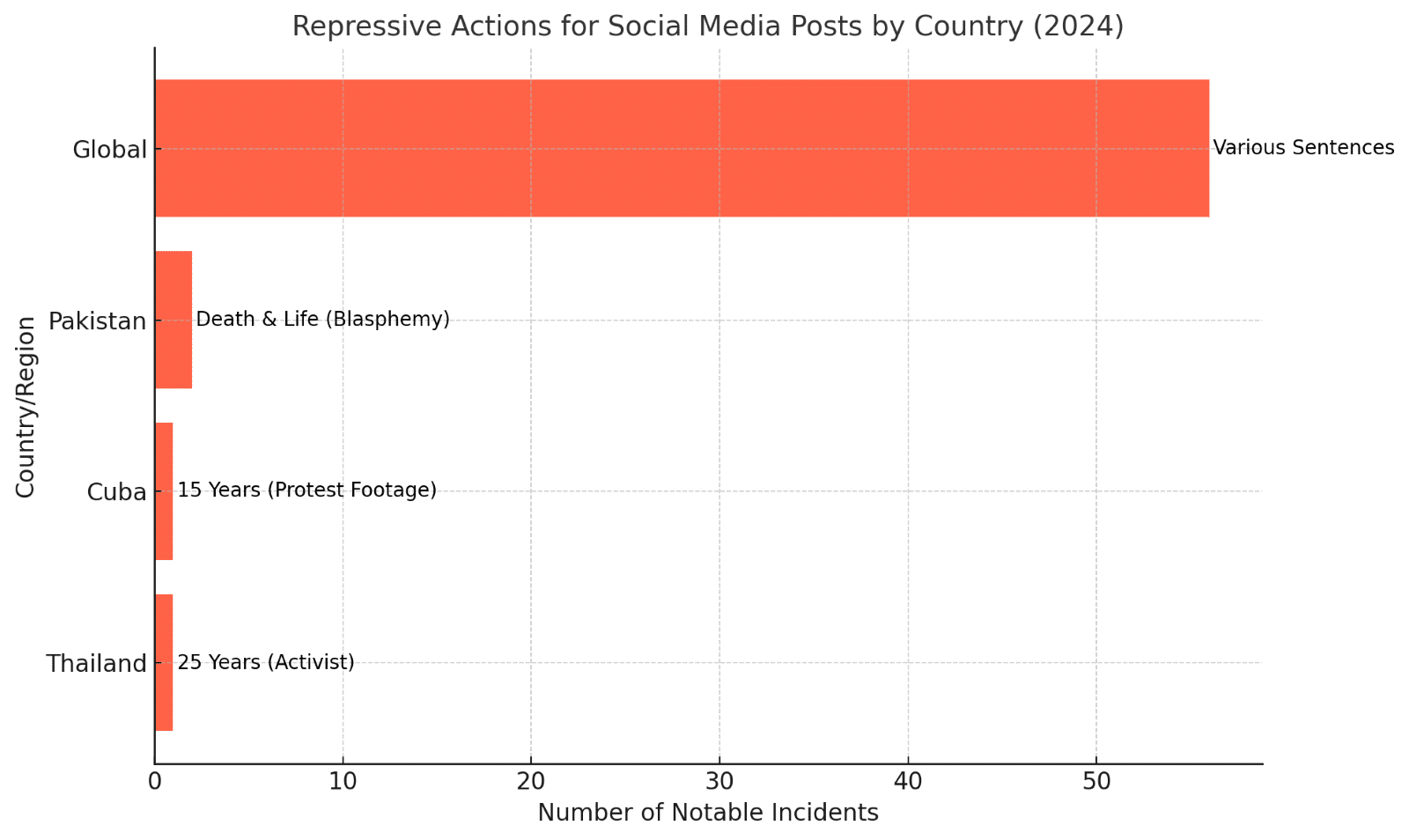
Harsh sentences made headlines: in Thailand, a pro-democracy activist got 25 years in prison in March 2024 under lèse-majesté laws for 18 tweets criticizing the monarchy. Cuba sentenced a woman to 15 years for “enemy propaganda” after she shared protest footage on Facebook.
In Pakistan, courts imposed the death penalty on a 22-year-old and life in prison for a 17-year-old over allegedly blasphemous content shared via WhatsApp. Such extreme cases underscore the risks: as of 2024, 79% of global internet users live in countries where posting political, social, or religious content could lead to arrest. In many places, activists, and journalists faced not only prosecution but violence for their online activities, further chilling free expression.
Platform Moderation Statistics and Policies
Major social media companies released data revealing the scale of content moderation (and raising debates about bias and “shadowbanning”). Platforms removed millions of posts and accounts for violating policies in 2024, using a mix of AI automation and human review:
Content Removal Volume
YouTube consistently removes in the order of 9–10 million videos per quarter because of the Community Guidelines violations. In 2023 alone, it took down 9.0 million videos worldwide, with 2.25 million (25%) from India – the single largest country source.
X reported in its 2024 transparency update that it removed over 10.6 million posts and suspended 5.3 million accounts globally in just six months.
Meta (Facebook & Instagram) similarly removes millions of pieces of content daily across categories like hate speech, nudity, and misinformation.
Automated Moderation (AI)
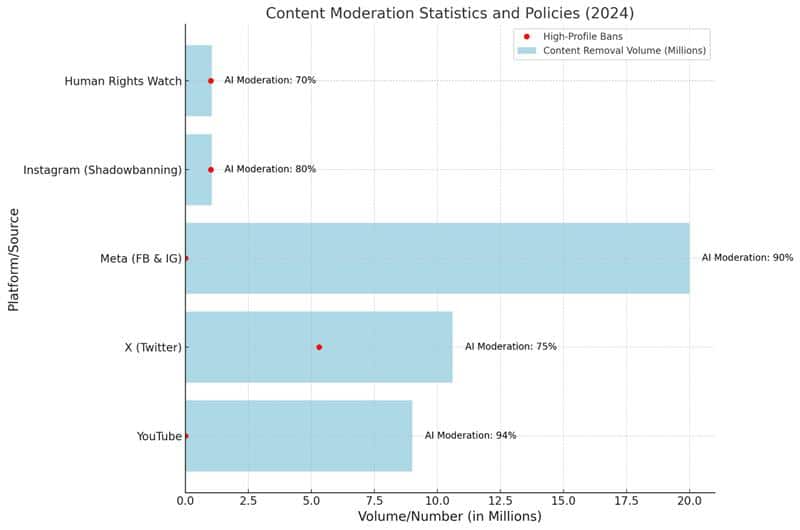
A significant majority of content policing is now done by AI.
YouTube reports that 94% of violative videos are first detected by automated systems, and 75% are removed before they get 10 views.
Meta also leverages machine learning and computer vision to flag content; roughly 90% of hate speech removed on Facebook is caught proactively by AI before users report it.
This automation at scale helps keep most users from ever seeing prohibited content. However, AI moderation isn’t perfect – it can err by both over-censoring (taking down benign posts) and under-censoring (missing nuanced hate or misinformation).
“Shadowbanning” and Bias Allegations
2024 saw heated debates over whether platforms secretly suppress certain political or cultural content.
During the Israel–Gaza war (Oct 2023 onward), Instagram was widely accused of shadowbanning pro-Palestinian content – i.e. reducing its visibility algorithmically without notice. Users reported their Stories and posts about Palestine received drastically fewer views and that their accounts became hard to search or interact with. Hundreds of such reports were collected by digital rights groups, indicating a pattern of Palestinian voices being down-ranked or hidden. Meta denied intentional bias, blaming a technical bug and automated safety filters for Arabic content that mistakenly flagged many benign posts.
Nonetheless, Human Rights Watch documented over 1,050 removals or suppressions of pro-Palestine content on Meta’s platforms in Oct–Nov 2023 alone, calling it “systemic and global” censorship of one side of a conflict.
Similar charges of bias came from other quarters (conservatives in the U.S. often claim platforms shadowban right-wing content, though data is mixed). These incidents highlight the trust deficit – users suspecting hidden moderation – and have prompted calls for greater transparency. Under Europe’s DSA, for example, very large platforms must now explain their algorithms and content curation systems to regulators and users, partly to address these opacity concerns.
Notable Account Suspensions
Despite the push for freer speech, platforms did enforce rules on high-profile figures. In late 2022 and into 2023, Kanye West (Ye) was suspended from major platforms for anti-Semitic posts, and in 2023 Andrew Tate remained banned on most services for past policy violations, though he found refuge on Twitter after Musk’s takeover.
Political leaders also faced action: Twitter (pre-Musk) famously banned former U.S. President Trump in Jan 2021 (he was reinstated in late 2022 by Musk, but as of 2024 he had not resumed tweeting). In India, opposition politicians saw tweets withheld or accounts blocked on government request during protests. And as noted, X in Turkey blocked several journalists’ and activists’ accounts during the 2023 election period under government pressure. These cases show that who gets banned or reinstated often depends on platform policy shifts at the highest level – a trend closely watched by users and regulators alike.
Economic Impact of Censorship
The financial fallout of internet censorship in 2024–2025 has been significant, affecting national economies, tech companies, and digital entrepreneurs alike:
Cost of Internet Shutdowns
Government-imposed internet disruptions come with a steep economic price tag. In 2024, intentional internet outages (including nationwide blackouts and social platform blocks) cost the global economy an estimated $7.69 billion. This figure, calculated by monitoring group Top10VPN, represents lost productivity, e-commerce, and investor confidence due to ~88,000 hours of shutdowns worldwide.
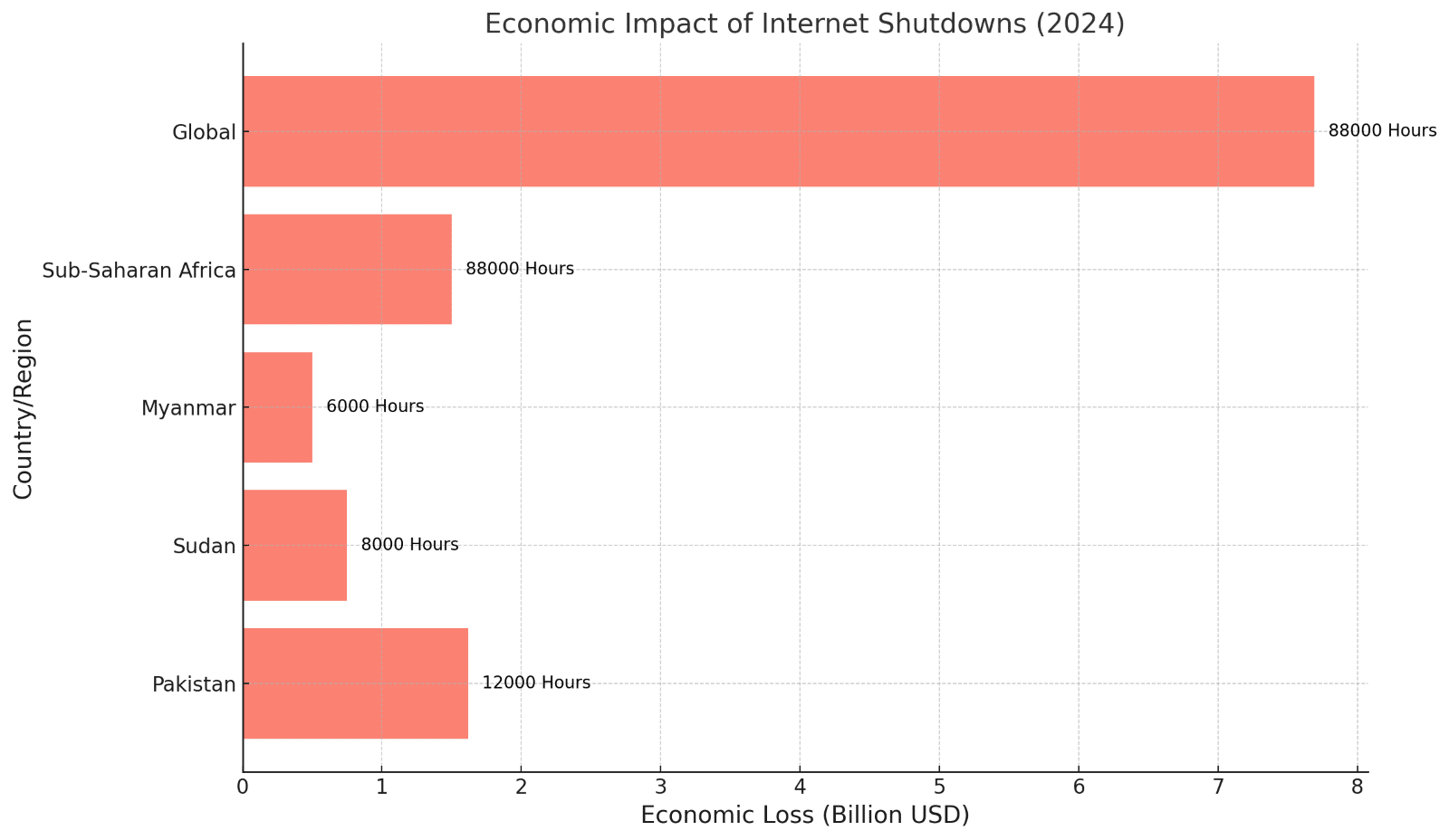
While slightly lower than the ~$9.2 billion loss in 2023 (a year with longer shutdowns in places like Russia and Ethiopia), 2024’s increase in the number of countries affected spread the economic pain more widely. Pakistan, Myanmar, and Sudan bore the highest losses in 2024 – Pakistan alone lost about $1.62 billion to various shutdowns (including long social media blocks and a nationwide cellular blackout on its election day).
In Africa, at least 13 countries experienced shutdowns in 2024, leading to a cumulative $1.5 billion loss for sub-Saharan Africa (led by Sudan’s protracted outages amid conflict). These figures underscore that internet disruptions don’t just silence speech – they also hamstring economies, disrupting banking, trade, and digital livelihoods. Over the past five years, the global trend of rising shutdowns has likely cost tens of billions of dollars in total, a self-inflicted economic wound especially damaging in developing countries.
Platform Revenue and Market Losses
Social media companies themselves can lose substantial business due to censorship policies. A stark example is TikTok’s ban in India – India had been TikTok’s biggest international market (over 200 million users) before the 2020 ban. ByteDance, TikTok’s parent, reportedly estimated that the India ban could cost it up to $6 billion in lost revenue, after sinking heavy investments into that market.
Similarly, when countries like Indonesia or Bangladesh have temporarily banned platforms (TikTok, YouTube, etc.), those companies forgo ad revenue and creator engagement during the ban. Elon Musk claimed Twitter’s ad revenues dropped globally in late 2023, in part due to advertiser concerns over loose moderation— a reminder that a platform perceived as too lax (or too strict) can face economic backlash from advertisers.
On the flip side, censorship can create market opportunities for alternatives: e.g. after India’s TikTok ban, domestic apps like Josh and Moj gained millions of users; when Western services are blocked in China or Russia, local equivalents (WeChat, VKontakte, etc.) thrive, capturing the advertising spend. Thus, censorship redistributes economic activity in the tech sector, often benefiting homegrown platforms or VPN services at the expense of global ones.
Impacts on Businesses and Users
For ordinary businesses and internet users, social media censorship has real costs. Small businesses that rely on Facebook or Instagram for sales suffer when these platforms are blocked, losing access to customers. Influencers and content creators can lose income when their reach is curtailed by moderation or bans.
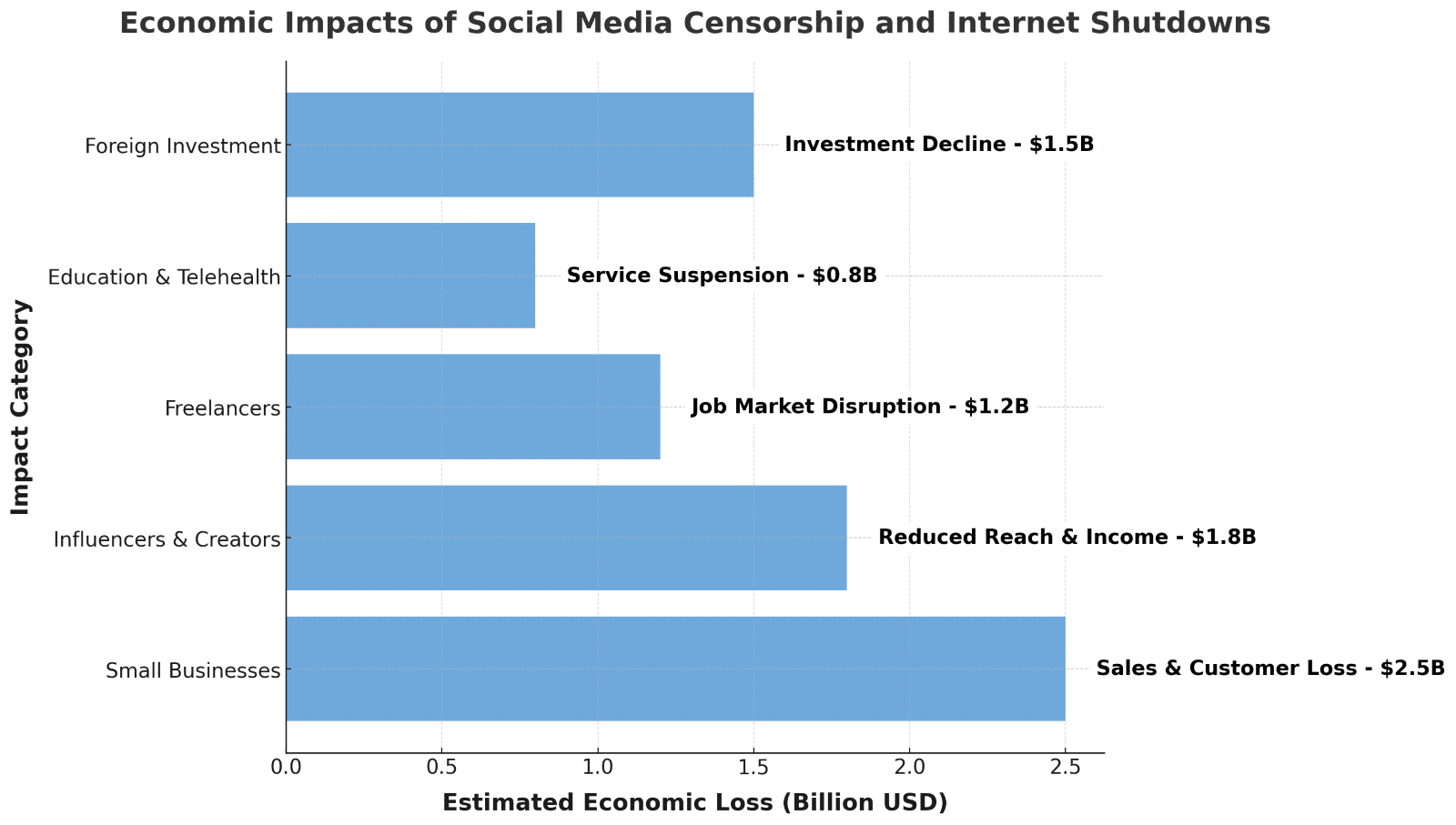
Internet shutdowns in places like Kashmir or Myanmar have cut off freelancers from online job markets for weeks or months, directly hitting incomes. Education and telehealth are also disrupted (e.g. during shutdowns in Sudan in 2023–24, online classes and remote medical consultations halted). Censorship can even spook foreign investment – companies may hesitate to invest in a country with unreliable internet access or heavy-handed digital laws.
In sum, beyond the headline numbers, there are countless microeconomic losses: entrepreneurs unable to access marketplaces, gig workers losing gigs, and communities cut off from crowdfunding or remittance platforms. The digital economy’s growth is closely tied to free flow of information, so censorship acts like a brake on economic development.
Emerging Trends and Future Outlook
As social media censorship evolves, several emerging trends are defining 2024–2025:
AI-Powered Censorship and Surveillance
Advances in artificial intelligence are a double-edged sword.
On one hand, authorities are adopting AI to enforce censorship more effectively – using machine learning to scan and filter posts at scale, or to identify dissidents.
For example, Myanmar’s military junta rolled out new censorship tech in 2024 capable of blocking VPNs and filtering content more aggressively, cutting off tools citizens used to bypass controls. China continues to invest heavily in AI for monitoring everything from text to video streams on its networks, including facial recognition to link online activity to real identities.
On the other hand, platforms themselves leverage AI to moderate content (as discussed) and also to detect coordinated manipulation (bots, fake accounts) that often accompany state-sponsored propaganda. The race is on between censors’ AI and circumvention AI: researchers are developing AI systems to detect censorship and route around it, while regimes try to use AI to predict and stamp out “forbidden” speech in real time.
The Expanding “Splinternet”
The vision of a global, open internet is increasingly giving way to a fragmented “splinternet” divided along national or ideological lines.
China’s Great Firewall remains the most prominent example – Chinese users exist in an alternate online universe (Weibo, WeChat, TikTok’s China version Douyin) walled off from global social media.
In 2024, Russia intensified efforts to create its own sovereign internet: it passed rules to route domestic traffic through state-controlled points and continued to block Western platforms and many foreign news sites.
Iran has long restricted social media and is moving toward a “National Information Network” that could operate even if cut off from the global web. This trend is not limited to authoritarian states: Western democracies are also asserting digital sovereignty in softer ways (data localization laws, demanding local content moderation teams, etc.), which could inadvertently contribute to fragmentation.
The EU’s regulations mean that European users might have a substantially different social media experience (with stricter content rules and fewer algorithmic feeds) than U.S. users on the same platform. If geopolitical tensions persist, we may see deeper fractures – e.g. a U.S.-led bloc versus a China/Russia-led bloc – with tech companies forced to choose markets.
The splinternet’s expansion threatens the idea that information (and user-generated content) flows freely across borders; instead, your location increasingly determines what you can see or say online.
Rise of Decentralized and Alternative Platforms
In response to both corporate moderation policies and government censorship, many users and developers are exploring decentralized social networks.
These are platforms like Mastodon, Bluesky, and Matrix/Element that don’t rely on a single corporate entity.
Mastodon, part of the Fediverse, saw a surge of interest after Musk’s takeover of Twitter – its user base jumped from about 3 million to over 6 million users in late 2022 and kept growing in 2023. By late 2023, Mastodon reported over 1.8 million monthly active users spread across thousands of independent servers, all interoperating. The appeal is that moderation on these platforms is community-specific: if one server imposes heavy-handed censorship, users can migrate to a more permissive server, mitigating the risk of a single point of control.
Similarly, Bluesky (a Twitter-like service funded by Jack Dorsey) introduced the AT Protocol to allow a future network of interlinked communities rather than one central site. While still relatively small, these decentralized networks are seen as censorship-resistant because no government can easily take them down (they have no headquarters to pressure) and no single company algorithms decide reach.
That said, decentralization brings challenges: hate or misinformation can also find havens, and new moderation models are being tested to balance free speech with abuse prevention. Encrypted messaging apps like Telegram and Signal also grew in popularity as alternatives to public social media, especially in countries with heavy censorship – though governments have attempted to block these as well (Russia and Iran both temporarily blocked Telegram in recent years, and Telegram itself has had to remove some channels under pressure).
Circumvention and User Adaptation
As censorship rises, so do efforts to circumvent it. The usage of VPNs (Virtual Private Networks) and proxy tools has skyrocketed in censored environments. When Twitter, Facebook, or WhatsApp are banned, millions of users immediately turn to VPN apps to tunnel out to the open internet – for instance, after Twitter was blocked in Nigeria (2021) and Turkey (2023), VPN downloads in those countries spiked by well over 1,000%.
Technologists are also developing new anti-censorship tools: encrypted DNS to hide what websites are being visited, domain fronting and mirror sites to evade blocks, and even satellite internet like Starlink to provide connectivity beyond government control (Starlink was activated in Ukraine in 2022 to bypass Russian attempts at communication blackouts, and there were calls to deploy it in Iran and Gaza during crises).
In the long run, a cat-and-mouse dynamic has set in – every time authorities up the censorship tech, users find creative ways around it. This dynamic is now a core part of the social media landscape: from Hong Kong protesters using AirDrop and mesh networks when the internet is cut, to Iranian youth using Tor and Psiphon to get to Instagram.
Global Norms and Resistance
Lastly, there’s an emerging global conversation about digital rights.
International watchdogs and coalitions (like Access Now’s #KeepItOn campaign and Freedom House’s Freedom on the Net report) are coordinating to highlight censorship and push for norms against tactics like network shutdowns.
In 2024, the UN Human Rights Council made statements against internet shutdowns, and some countries like the USA have started sanctioning foreign officials responsible for major censorship incidents. This trend of calling out and penalizing censors internationally may grow.
At the same time, censorship methods are also spreading – dozens of countries have copied Russia’s “fake news” laws or India’s traceability requirements for messaging apps. The period of 2024–2025 is thus a pivotal one where the world is grappling with how to balance regulation of online content with the need to preserve free expression. The data shows a concerning rise in restrictions but also increasing pushback from civil society and some courts. Going forward, the trajectory of social media censorship will likely be shaped by this tension – between the impulse to control the narrative and the imperative to keep the internet open and global.
Sources:
“Decentralized Social Media and What It Means for the Future.” Hire A Writer, https://www.hireawriter.us/social/decentralized-social-media-and-what-it-means-for-the-future#:~:text=Future%29%20www,This.
“Government-Imposed Internet Shutdowns Cost Over USD 7 Billion in 2024 and Pakistan Was the Most Affected Nation.” TechRadar, https://www.techradar.com/vpn/vpn-privacy-security/government-imposed-internet-shutdowns-cost-over-usd7-billion-in-2024-and-pakistan-was-the-most-affected-nation.
“Africa Lost $1.5 Billion to Internet Shutdowns in 2024.” TechPoint Africa, https://techpoint.africa/news/africa-lost-1-5-billion-to-internet-shutdowns-in-2024/.
“Meta’s Broken Promises: Systemic Censorship of Palestine Content on Instagram and Facebook.” Human Rights Watch, 21 Dec 2023, https://www.hrw.org/report/2023/12/21/metas-broken-promises/systemic-censorship-palestine-content-instagram-and#:~:text=Between%20October%20and%20November%202023%2C,countries%20around%20the%20world%2C%20primarily.
“DSA Enforcement.” European Commission Digital Strategy, https://digital-strategy.ec.europa.eu/en/policies/dsa-enforcement#:~:text=strategy,of%3A%20Breach%20of%20DSA.
“Internet Shutdowns 2024.” Access Now, https://www.accessnow.org/internet-shutdowns-2024/#:~:text=In%202024%2C%20Access%20Now%20and,for%20more%20than%20a%20year.






